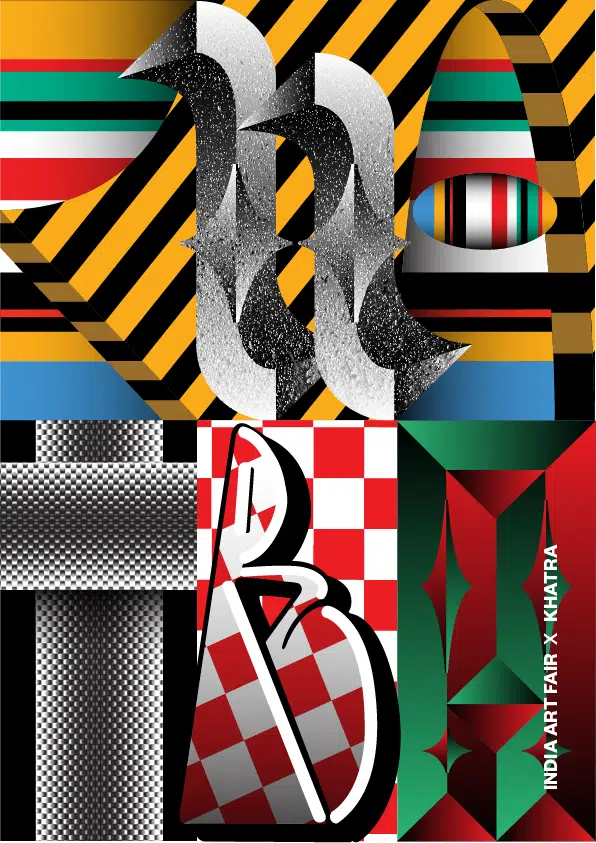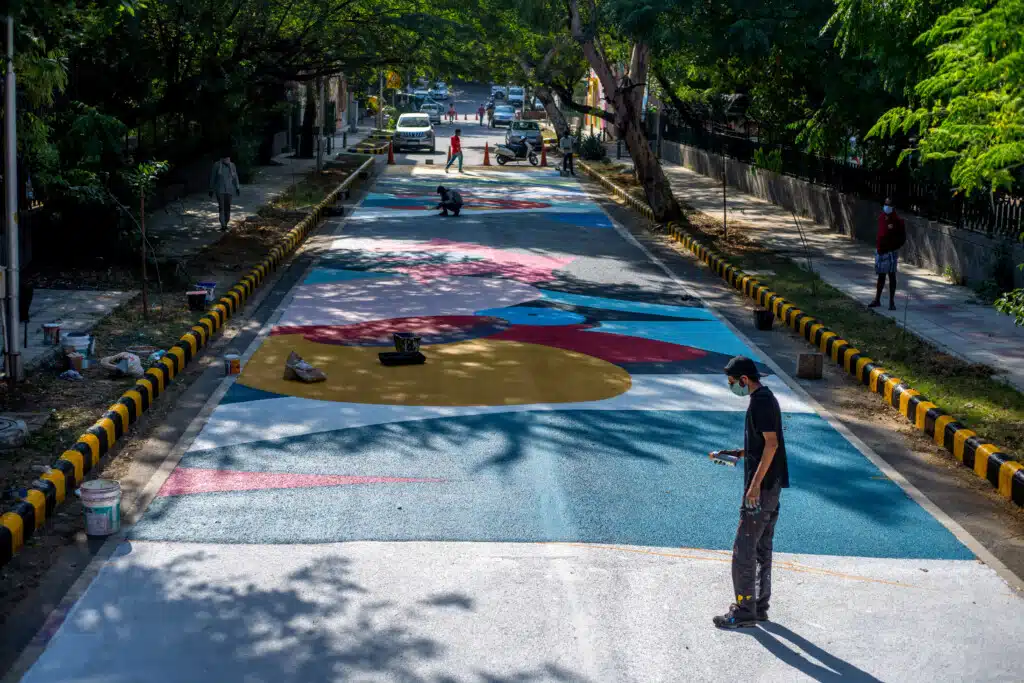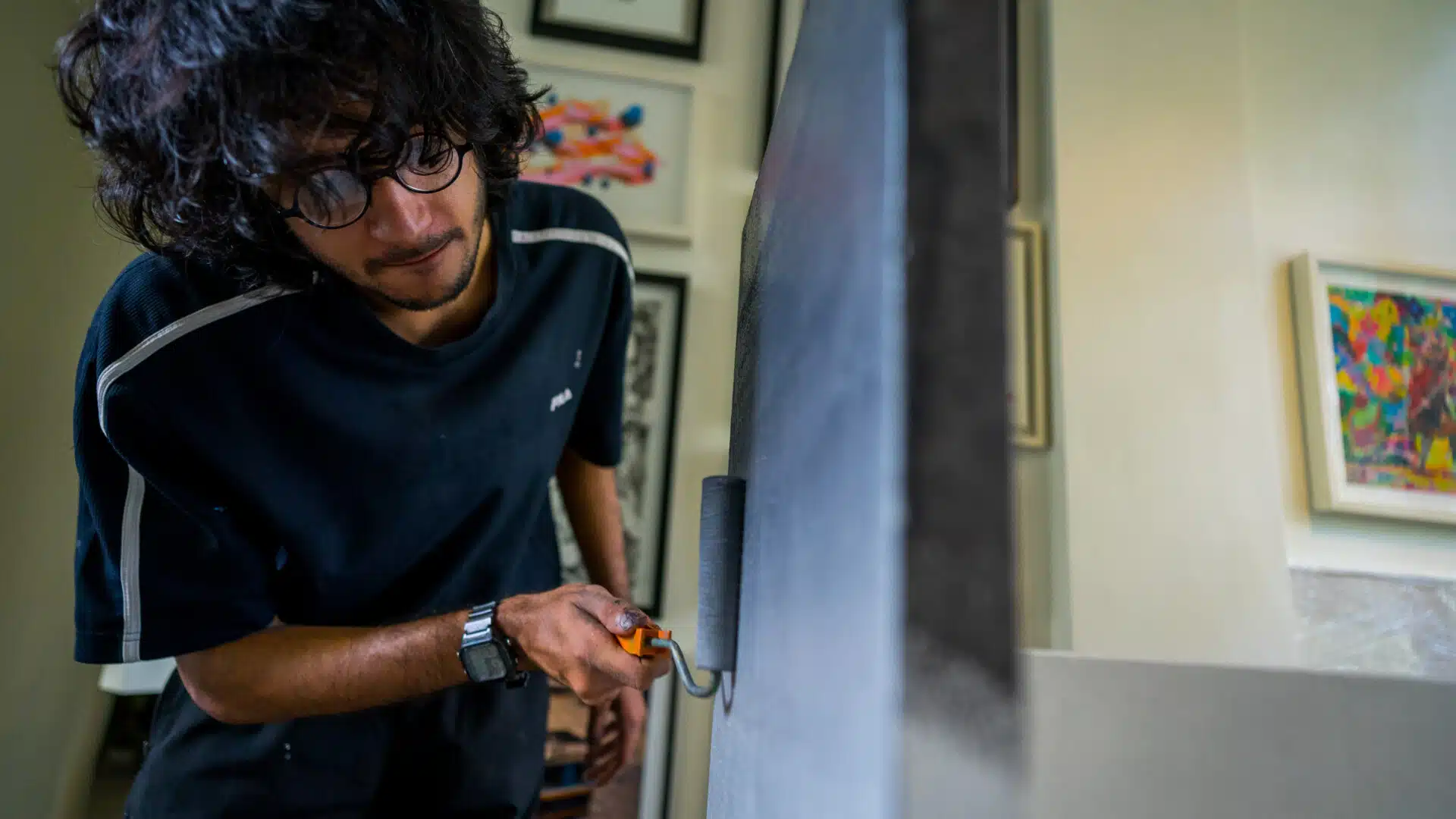Siddharth Gohil goes by the alias, Khatra, a tongue-in-cheek warning, cautioning us of his ‘danger’ to comfortable societal and art-world norms. The graffiti and mural artist, now based in Baroda, Gujarat, after having lived for many years in New Delhi, seeks to bring art to people outside of gallery spaces and into the streets — and engage with social and political issues, directly, in the public eye. Playing with geometric abstraction and typography at large scales in public spaces throughout the country, including at venues such a cycling track in New Delhi’s Lodhi Colony, the facade of Chennai’s Indira Nagar Railway Station and the historic Sassoon Dock in Mumbai, the artist has left his mark throughout the country’s urban hubs.
DOWNLOAD A SPECIAL ARTIST POSTER >

Despite Khatra’s attraction to the city as his canvas, his origins are in small-town India. “I grew up in coastal Gujarat in a small place called Talaja, in a family of tailors, from whom I got my sense of form and colour,” he says, describing a childhood spent around his father, cutting textiles, sewing and making patchworks, techniques that have stayed with Khatra even as a street artist. “I also used to love drawing letters in my cursive writing classes and would spend hours with my workbooks.” The interest in experimenting with colour, form and typography led the artist to pursue a degree in graphic design at the Maharaja Sayajirao University in Baroda, Gujarat. In fact, Gohil’s transformation into ‘Khatra’ took place almost as an accident, during a short stint volunteering for a festival organised by St+art India, a public art project, at the end of which the leftover paints and spray cans were given over to the volunteers, including Khatra and his classmate Nikunj Prajapati. The artist remembers pairing off with Prajapati — who has since become a street artist himself, going by the alias ‘do’, and Khatra’s closest artistic collaborator — and finding an abandoned terrace to cover with paint. “We stayed on the terrace for two continuous days,” Khatra shares, “not caring about the harsh Delhi winter nights.” Khatra’s career as a street artist has grown gradually since then, working first with St+art India as a graphic designer and then as an artist with St+art and numerous other art spaces.
“I am interested in representing an Indian aesthetic of graffiti art which has not been defined so far.”
“I respond to the surface,” Khatra says. “I use various styles and mediums, and my treatment really depends on where I am working.” The artist begins each work with some preparatory exercises at home, involving digital drawings and experiments on physical forms, through which he arrives at the basic concepts and principles for the work. However, these plans can and do all change on site and while executing the project, during what Khatra calls the “stage of fun.” A straightforward human figure might erupt into a series of abstracted forms, for example, in the process of translating a drawing on an A4 sheet of paper into a 50ft by 20ft wall.
Playing with typography has remained central to Khatra’s practice. For a mural project commissioned at an all girl’s school in Jaisalmer, Rajasthan earlier in 2023, the artist “designed almost a puzzle for the students, made with intertwining alphabets in Hindi and English. Even while I was creating the mural,” Khatra shares, “the children would come and see if they could find letters in what I was making — it was kind of a game.” Surrounded by miles of desert and inspired by the typical sandstone architecture of the region, Khatra’s letters also took on the tones of his surroundings, becoming a mirage of beiges and greys, with the building blocks of his work and practice hidden within — the basic forms of the alphabet.

Khatra in the process of completing a ‘painted’ cycle lane in Lodhi Colony in 2020. Courtesy of the artist.
Even though Khatra has built up a practice creating murals and street art commissioned by major institutions and organisations over the years, he retains a special place in his heart for informal graffiti — through which artists can convey a “message without permission”. This spirit of rebellion carries through throughout his practice — “I am interested in representing an Indian aesthetic of graffiti art which has not been defined so far.”
The artist is currently working on a mural for the entrance of the Jim Corbett National Park, Uttarakhand, India, one the country’s most visited National Parks, with imagery of the Park’s famous tigers amongst plastic waste, calling attention to the impact of rapid human development on the natural world.
Siddharth ‘Khatra’ Gohil was born in 1992 in Talaja, Gujarat. His work will be shown at India Art Fair 2024 as part of its Artists in Residence programme.


